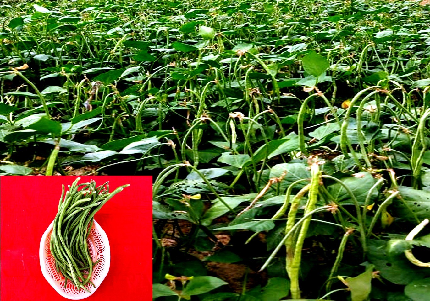For decades, cowpea (lobia) has been a staple in Indian kitchens, valued for its nutrition and versatility. Yet for farmers, traditional varieties often meant uneven yields, late harvests, and vulnerability to diseases like Cowpea Golden Mosaic Virus (CGMV). Recognizing the need for a reliable, high-yielding, and market-friendly option, scientists at the ICAR–Indian Institute of Vegetable Research, Varanasi developed Kashi Nidhi a variety that has quickly become a farmer’s favorite across the country.
Kashi Nidhi was designed to solve three key challenges low yields, late maturity, and disease susceptibility. Compact and bushy, with a manageable height of 45–50 cm, the plants are easy to cultivate even in small plots or intensive cropping systems. Its photo-insensitive nature allows flexible sowing in both summer and rainy seasons, making it suitable for diverse regions.
Within 35–40 days of sowing, the plants begin to flower, and by 50–55 days, farmers are ready to harvest a remarkable improvement over traditional varieties that take much longer. This early maturity not only ensures quick returns but also enables farmers to integrate cowpea into multiple cropping cycles, boosting overall farm productivity.

One of the defining features of Kashi Nidhi is its attractive, dark green, slightly curved pods of uniform size. Each plant bears 40–45 pods, with a remarkable green pod yield potential of 140–150 quintals per hectare. The pods are long (32.5 cm) and heavy (110 g), qualities that have made them highly preferred in wholesale and retail markets alike. This uniformity and visual appeal give farmers a competitive edge in commercial markets where quality dictates price.
Kashi Nidhi also brings resilience to farmers’ fields with its resistance to Cowpea Golden Mosaic Virus, one of the most destructive diseases in cowpea cultivation. This built-in resistance reduces the need for frequent chemical sprays, cutting production costs while promoting eco-friendly farming practices. With a modest seed rate of 20–25 kg per hectare, farmers find the crop economical, efficient, and highly profitable.
The adoption of Kashi Nidhi has brought measurable change to farming communities. Farmers report not only higher net incomes but also greater satisfaction due to its reliability, reduced crop losses, and strong demand in markets. For many smallholders, the variety has become a stepping stone to livelihood security providing assured harvests in shorter durations and helping them diversify incomes.
From commercial farms to kitchen gardens, Kashi Nidhi is now recognized as a game-changer in cowpea cultivation. Its combination of early maturity, high yields, disease resistance, and strong market acceptability makes it one of the most widely adopted and trusted varieties in India. By bridging the gap between farmer needs and consumer preferences, Kashi Nidhi is not just a variety it is a symbol of innovation translating into prosperity.
(Source: ICAR–Indian Institute of Vegetable Research, Varanasi)








Like on Facebook
Subscribe on Youtube
Follow on X X
Like on instagram